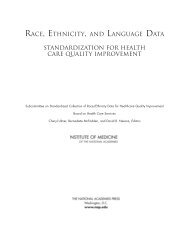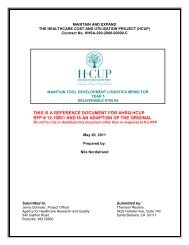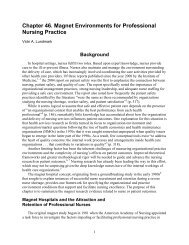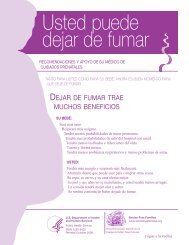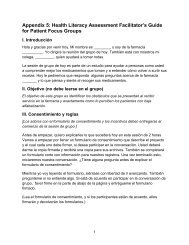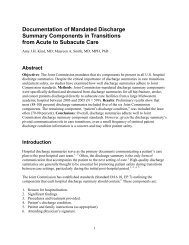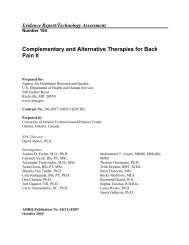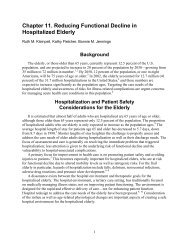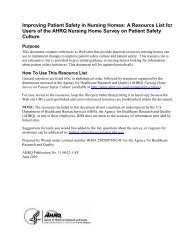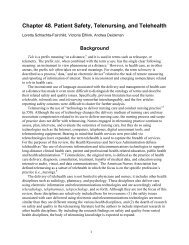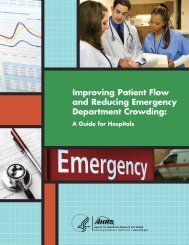Stories of Success: Using CUSP To Improve Safety - Agency for ...
Stories of Success: Using CUSP To Improve Safety - Agency for ...
Stories of Success: Using CUSP To Improve Safety - Agency for ...
You also want an ePaper? Increase the reach of your titles
YUMPU automatically turns print PDFs into web optimized ePapers that Google loves.
One <strong>of</strong> those “little things” arose when an ICU nurse made a drug error because the small vial<br />
packaging print was very difficult to read. Now there are magnifying glasses all over the ICU.<br />
Hickman noted, “When a defect comes back to you, you fix it better than you did be<strong>for</strong>e so it<br />
stays fixed.”<br />
There is a <strong>CUSP</strong> communications book at the nurses’ station, but one <strong>of</strong> Hickman’s favorite<br />
modes <strong>of</strong> communication was to post fixes and important in<strong>for</strong>mation in the staff bathroom. She<br />
said, “If I know it, you’re going to know it. People come to our bathroom from other floors just<br />
to see what’s going on.” Like Morris, she had developed effective ways <strong>of</strong> communicating with<br />
physicians. She didn’t try to have a sit-down meeting, but was always prepared and got right to<br />
the point when she ran into one <strong>of</strong> them in the elevator, hallway, or parking lot. She also spoke to<br />
them privately.<br />
Hickman elaborated on <strong>CUSP</strong>’s effect on safety culture:<br />
“It’s much harder to deal with this big culture balloon and all the things inside <strong>of</strong> it—like<br />
people not talking with each other, not collaborating. Now with <strong>CUSP</strong>, you’ve got<br />
doctors and nurses and others talking to each other and collaborating. Once you get this<br />
culture thing going, then it’s easier to take on other health care associated initiatives and<br />
get buy-in because people are already connected.”<br />
Like Hickman, Morris was enthusiastic about how <strong>CUSP</strong> had enhanced nurse-to-nurse and<br />
nurse-doctor communication.<br />
“<strong>CUSP</strong> gives us an objective process (Daily Goals) through which the nurses and the<br />
doctors involved discuss the patient’s case on a daily basis—here are the expected<br />
outcomes <strong>for</strong> the day, and here is what is in fact going on. Good doctors have always<br />
done this well, and experienced nurses can get it out <strong>of</strong> the doctors, but <strong>CUSP</strong> gives new<br />
nurses a tool to get mumbling and tight-lipped physicians to tell them what they’re<br />
thinking.”<br />
Hons, who now co-leads the <strong>CUSP</strong> team, described Daily Goals as a “tool to help me be more<br />
effective as a nurse, to take better care <strong>of</strong> my patients while taking care <strong>of</strong> my coworkers as<br />
well.”<br />
Peterson had been working on developing a non-blaming culture <strong>for</strong> the past several years. Staff<br />
have come to understand that when an error is made, or a mistake reaches the patient, most <strong>of</strong> the<br />
time, it’s because the system has failed. Rather than an individual being fired (unless the incident<br />
is egregious), they are re-educated, and the system is fixed where possible or made transparent so<br />
that everyone is aware <strong>of</strong> the potential problem. <strong>CUSP</strong> modules on the science <strong>of</strong> safety have<br />
extended and deepened the shared understanding <strong>of</strong> how broken systems set staff up to fail, and<br />
affirmed a culture where staff are more likely to report system failures or defects.<br />
Critical Moments<br />
Peterson’s journey to standardization <strong>of</strong> CLABSI and ventilator-associated pneumonia (VAP)<br />
bundles and nurse empowerment is marked by evolutionary trends rather than dramatic shifts in<br />
practice or culture. When hospital policy and procedures were revised in 2010 to make using the<br />
central line insertion and maintenance bundles standard house-wide, it built upon several years <strong>of</strong><br />
10



